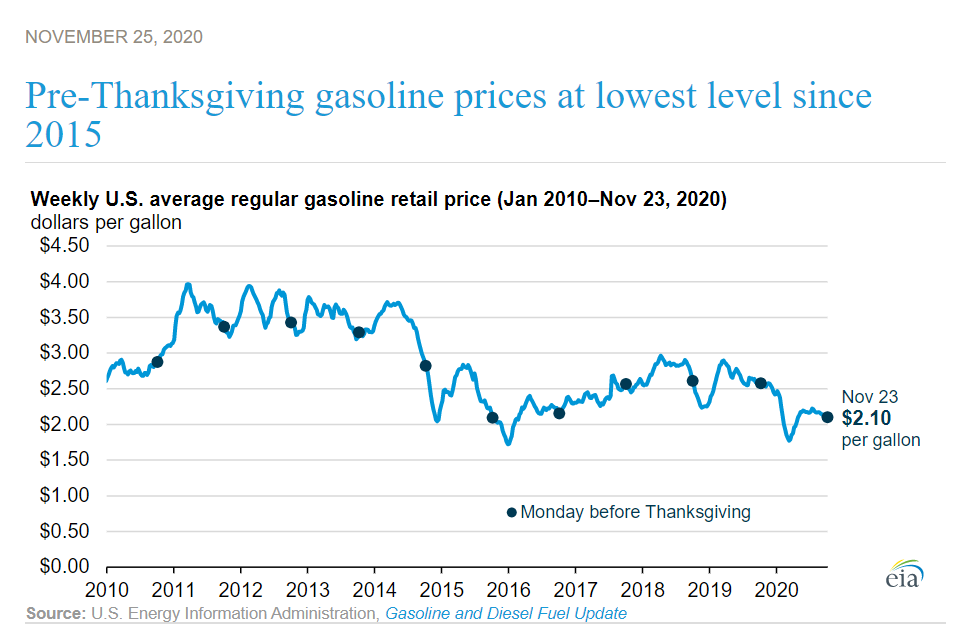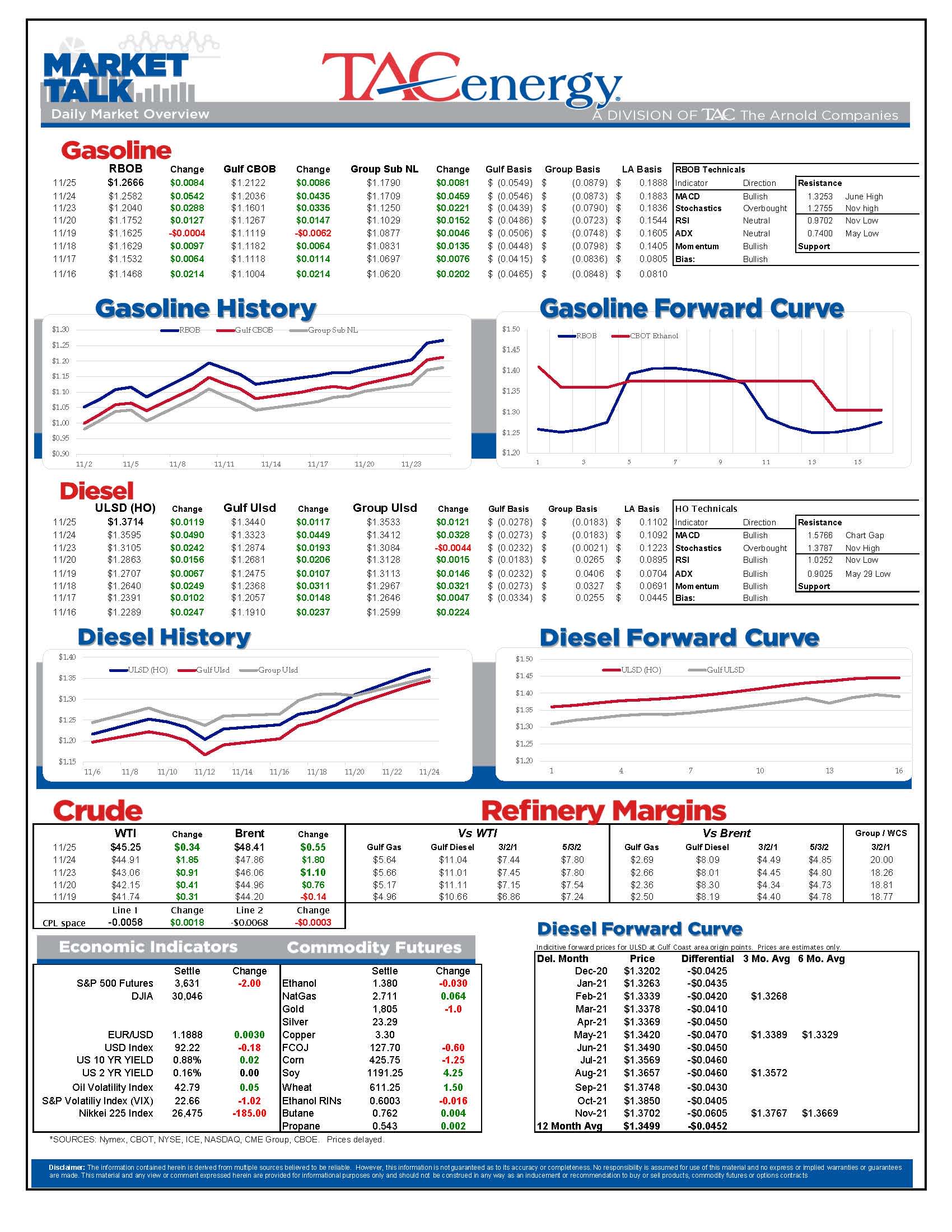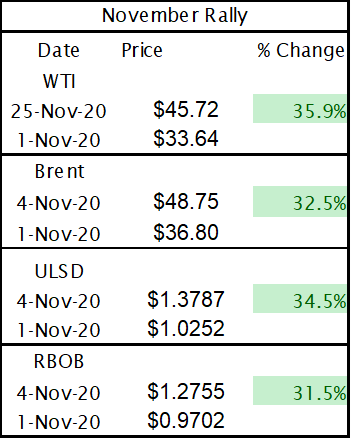Oil And Diesel Prices Hitting Fresh 8 Month Highs

Oil and diesel prices are hitting fresh 8 month highs this morning and the big 4 petroleum futures contracts are now each up more than 30% from the lows set November 1st with a variety of technical and fundamental factors contributing to the surge.
The DJIA breaching 30,000 seems to be giving plenty of sentimental boost as investors are taking a risk-on stance, and there is clear technical momentum now that the top end of the long-lasting sideways trading range has finally broken.
Perhaps most notable on the charts is that ULSD futures finally filled the gap in their chart left behind during the March collapse. There’s still another 20 cents of upside for distillates to reach their March highs, but short term warning signals are suggesting the contract is overbought following an 8 day streak of gains, and due for a corrective pull back in the near future.
Expectations that OPEC & Friends will be forced to extend output cuts, and another missile strike on Saudi Arabian energy infrastructure are both getting credit for the fundamental reasoning for this rally. The good news is the Saudi facility suffered minimal damage from the missile that was reportedly able to travel more than 300 miles through the air, but was apparently unable to break through the outer wall of a diesel storage tank.
The API was said to show builds in crude oil and gasoline inventories last week of 3.8 and 1.3 million barrels respectively, while distillates drew by 1.8 million barrels. The builds in inventory were getting credit for a pause in the rally overnight, but seem to be ignored now that the buyers have stepped back in. The DOE/EIA’s weekly status report is due out at its normal time this morning.
An EIA note this morning shows US gasoline prices are holding near their lowest in 10 years heading into what is traditionally the busiest travel day of the year. The note also highlights the expected reductions in travel this Thanksgiving holiday by car (4%) air (48%) and mass transit (76%) due to COVID.
That huge difference between automobiles (which primarily run on gasoline) and other transportation methods (which rely heavy on various distillates) is one of many challenges refiners are facing as they attempt to shift output to match the unprecedented changes in demand this year.
Speaking of which, there was yet another refining casualty this week as Total announced it was halting operations the Donges refinery in Western France due to poor economic conditions. The shutdown is expected to last several months, but the plant is moving forward with a major upgrading project suggesting that it could return to service once demand gets back to normal.
NYMEX contracts will trade Thursday and Friday, but only Friday’s trading will have a settlement. Spot markets will not be assessed either day, so most rack prices will carry through from tonight to Monday.
Click here to download a PDF of today’s TACenergy Market Talk.
Latest Posts
The Sell-Off Continues In Energy Markets, RBOB Gasoline Futures Are Now Down Nearly 13 Cents In The Past Two Days
Week 15 - US DOE Inventory Recap
Prices To Lease Space On Colonial’s Main Gasoline Line Continue To Rally This Week
Equity Markets Have Been Pulling Back Sharply In Recent Days As Inflation And Trade Concerns Inject A Sense Of Reality Into Stocks
Social Media
News & Views
View All
The Sell-Off Continues In Energy Markets, RBOB Gasoline Futures Are Now Down Nearly 13 Cents In The Past Two Days
The sell-off continues in energy markets. RBOB gasoline futures are now down nearly 13 cents in the past two days, and have fallen 16 cents from a week ago, leading to questions about whether or not we’ve seen the seasonal peak in gasoline prices. ULSD futures are also coming under heavy selling pressure, dropping 15 cents so far this week and are trading at their lowest level since January 3rd.
The drop on the weekly chart certainly takes away the upside momentum for gasoline that still favored a run at the $3 mark just a few days ago, but the longer term up-trend that helped propel a 90-cent increase since mid-December is still intact as long as prices stay above the $2.60 mark for the next week. If diesel prices break below $2.50 there’s a strong possibility that we see another 30 cent price drop in the next couple of weeks.
An unwind of long positions after Iran’s attack on Israel was swatted out of the sky without further escalation (so far anyway) and reports that Russia is resuming refinery runs, both seeming to be contributing factors to the sharp pullback in prices.
Along with the uncertainty about where the next attacks may or may not occur, and if they will have any meaningful impact on supply, come no shortage of rumors about potential SPR releases or how OPEC might respond to the crisis. The only thing that’s certain at this point, is that there’s much more spare capacity for both oil production and refining now than there was 2 years ago, which seems to be helping keep a lid on prices despite so much tension.
In addition, for those that remember the chaos in oil markets 50 years ago sparked by similar events in and around Israel, read this note from the NY Times on why things are different this time around.
The DOE’s weekly status report was largely ignored in the midst of the big sell-off Wednesday, with few noteworthy items in the report.
Diesel demand did see a strong recovery from last week’s throwaway figure that proves the vulnerability of the weekly estimates, particularly the week after a holiday, but that did nothing to slow the sell-off in ULSD futures.
Perhaps the biggest next of the week was that the agency made its seasonal changes to nameplate refining capacity as facilities emerged from their spring maintenance.
PADD 2 saw an increase of 36mb/day, and PADD 3 increased by 72mb/day, both of which set new records for regional capacity. PADD 5 meanwhile continued its slow-motion decline, losing another 30mb/day of capacity as California’s war of attrition against the industry continues. It’s worth noting that given the glacial pace of EIA reporting on the topic, we’re unlikely to see the impact of Rodeo’s conversion in the official numbers until next year.
Speaking of which, if you believe the PADD 5 diesel chart below that suggests the region is running out of the fuel, when in fact there’s an excess in most local markets, you haven’t been paying attention. Gasoline inventories on the West Coast however do appear consistent with reality as less refining output and a lack of resupply options both continue to create headaches for suppliers.

Week 15 - US DOE Inventory Recap

Prices To Lease Space On Colonial’s Main Gasoline Line Continue To Rally This Week
Energy markets are sliding lower again to start Wednesday’s trading as demand concerns and weaker stock markets around the world seem to be outweighing any supply concerns for the time being.
Rumors continue to swirl about an “imminent” response by Israel to Iran’s attacks, but so far, no news seems to be taken as good news in the hopes that further escalation can be avoided, even as tensions near the Red Sea and Strait of Hormuz continue to simmer.
Prices to lease space on Colonial’s main gasoline line continue to rally this week, trading north of 11 cents/gallon as Gulf Coast producers still struggle to find outlets for their production, despite a healthy export market. Gulf Coast CBOB is trading at discounts of around 34 cents to futures, while Gulf Coast RBOB is trading around a 16-cent discount, which gives shippers room to pay up for the linespace and still deliver into the East Coast markets at a profit.
Back to reality, or just the start of more volatility? California CARBOB basis values have dropped back to “only” 40 cent premiums to RBOB futures this week, as multiple flaring events at California refineries don’t appear to have impacted supply. The state has been an island for fuel supplies for many years as its boutique grades prevent imports from neighboring states, and now add the conversion of the P66 Rodeo refinery to renewable diesel production and the pending changes to try and cap refinery profits, and it’s easier to understand why these markets are increasingly vulnerable to supply shocks and price spikes on gasoline.
RIN prices continue to fall this week, touching 44 cents/RIN for D4 and D6 values Tuesday, their lowest level in 6 weeks and just about a nickel above a 4-year low. While the sharp drop in RIN and LCFS values has caused several biodiesel and Renewable Diesel producers to either shut down or limit production, the growth in RIN generation continues thanks to projects like the Rodeo refinery conversion, making the supply in RINs still outpace the demand set by the Renewable Fuel Standard by a wide margin.
The API reported draws in refined products, 2.5 million barrels for gasoline and 427,000 barrels for distillates, while crude oil stocks had an estimated build of more than 4 million barrels. The DOE’s weekly report is due out at its normal time this morning.
Click here to download a PDF of today's TACenergy Market Talk.


